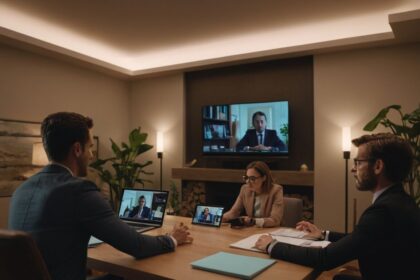In today’s increasingly digital workplace, effective virtual meeting etiquette has become crucial for maintaining professionalism and fostering clear communication. Navigating the nuances of online interactions requires more than just turning on your camera; it involves practicing good manners that promote respect and collaboration. When everyone adheres to common standards of conduct, meetings can be more productive and less prone to misunderstandings. By mastering these key guidelines, professionals can build rapport and ensure that their contributions are both noticed and valued in a virtual setting.
Principalele concluzii
- Ensure reliable technology, internet, and equipment checks before joining a virtual meeting.
- Create a quiet, well-lit environment and choose a professional background for clear communication.
- Dress appropriately and groom yourself neatly to maintain professionalism on camera.
- Join on time, test audio/video in advance, and be punctual to respect participants’ schedules.
- Maintain eye contact, actively engage, mute when not speaking, and follow the meeting agenda.
Prepare your technology and internet connection
Ensuring that your technology setup is reliable and functioning properly is a fundamental step before joining any virtual meeting. Take the time to check your internet connection stability, as sudden disruptions or slow speeds can hinder communication and cause delays. A high-quality connection helps ensure that audio and video are transmitted clearly and without interruption, making interactions smoother and more professional.
Additionally, test all necessary equipment in advance, including your microphone, speakers, and camera. This avoids unexpected issues during the meeting, such as muffled audio or poor video quality, which can be distracting for other participants. It is also beneficial to update your software or platform to the latest version, as updates often include bug fixes and new features designed to enhance your experience. By taking these steps ahead of time, you demonstrate responsibility and respect for others’ time, setting a positive tone for the meeting.
Lastly, consider having a backup plan in case technical difficulties arise—such as a secondary device or alternative connectivity options. Being prepared in this way minimizes disruptions and shows professionalism, while also helping to maintain focus on the discussion points without unnecessary interruptions.
Related topics: The Rising Popularity of Chinese Food: Exploring Trends and Traditional Dishes
Choose a quiet, well-lit environment for meetings

Choosing an environment that is quiet and free from distractions is key to participating in virtual meetings effectively. Background noise, such as conversations, ringing phones, or household sounds, can interrupt the flow of the discussion and make it difficult for others to focus. Therefore, finding a space where external noises are minimized helps maintain clear communication and fosters a professional atmosphere. Additionally, ensuring good lighting is equally important. A well-lit setting allows your video image to be clearly visible, which encourages more natural interactions and enhances non-verbal cues like facial expressions and gestures. Natural light is often preferable, but if that’s not possible, using sufficient artificial lighting without harsh shadows creates a balanced appearance.
It’s also worthwhile to consider the background that appears behind you during the meeting. A tidy, neutral backdrop reduces visual distractions and conveys a sense of organization. If working from home or a busy environment, use simple backgrounds or digital backgrounds provided by the platform, if available. Taking these steps demonstrates respect for colleagues’ time and attention, while also making the overall meeting experience smoother and more engaging for everyone involved.
Dress appropriately to maintain professionalism
When participating in virtual meetings, it is important to dress appropriately to uphold a professional appearance. Your choice of clothing sends a visual message about your attitude towards the meeting and those involved. Even though you may be working from home, dressing in a neat and tidy manner helps create a mindset that fosters focus and seriousness during discussions.
Opt for attire that aligns with the type of meeting and the organizational culture. For formal occasions or business environments, wearing a shirt, blouse, or blazer can make a positive impression. Casual clothes like t-shirts or sweatshirts are generally not suitable, as they might undermine perceptions of professionalism. Remember, what you wear is easily visible on camera, so choosing outfits that are clean and well-maintained contributes to a respectful presentation.
Another aspect to consider is personal grooming; paying attention to hygiene and neatness enhances your overall appearance. Good grooming demonstrates respect for both yourself and others, and it reinforces your credibility in professional settings. Ultimately, dressing properly for virtual meetings not only influences how colleagues perceive you but also boosts your own confidence—helping you engage more effectively in conversations and decision-making processes.
Good manners will open doors that the best education cannot. – Clarence Thomas
Test audio and video equipment before joining
Before joining a virtual meeting, it is crucial to test your audio and video equipment to ensure everything functions correctly. Technical issues during the call can cause interruptions that hinder communication and disrupt the flow of conversation. By taking a few moments beforehand, you can identify any problems with your microphone, speakers, or camera, which helps maintain a smooth meeting experience.
Start by checking your microphone to confirm that your voice is clear and loud enough for others to hear. If necessary, adjust the volume settings or replace faulty hardware. Similarly, verify that your camera provides a sharp image and that the angle captures your face properly. A good visual connection encourages better engagement and non-verbal feedback, which are vital parts of effective interaction.
It is also advisable to perform these tests close to the scheduled meeting time. This allows you to make quick adjustments if something isn’t working properly, avoiding delays once the session has started. Ensuring all technical elements are functioning in advance demonstrates initiative and respect for everyone’s time, resulting in a more focused and professional discussion.
Mai multe pe această temă: Taylor Swift și Travis Kelce: O privire în relația lor de profil înalt
| Sfat | Descriere |
|---|---|
| Prepare your technology and internet connection | Check your internet stability and test all equipment before the meeting to ensure smooth communication and avoid technical disruptions. |
| Choose a quiet, well-lit environment for meetings | Select a space free from background noise and with good lighting to enhance communication and professionalism. |
| Dress appropriately to maintain professionalism | Wear suitable clothing that reflects the meeting’s formality to make a positive impression and boost confidence. |
| Test audio and video equipment before joining | Verify that your microphone, speakers, and camera work correctly to prevent interruptions during the meeting. |
| Be punctual and join on time | Join the meeting promptly to respect others’ time and ensure the session starts smoothly. |
| Maintain good eye contact and active engagement | Look into the camera and participate actively to foster connection and show interest in the discussion. |
| Mute microphone when not speaking | Keep your microphone turned off to prevent background noise from disrupting the meeting. |
| Follow meeting agendas and participate constructively | Stick to the agenda and contribute thoughtfully to make meetings more efficient and effective. |
Be punctual and join on time

Starting a virtual meeting punctually demonstrates respect for everyone’s time and sets a professional tone from the beginning. Joining on time ensures that discussions begin promptly, allowing all participants to stay aligned with the agenda. Being punctual is also a sign of personal responsibility, showing that you value the commitments made and are committed to maintaining smooth communication channels.
It’s beneficial to log into the meeting a few minutes early, especially if there might be technical issues to resolve. This provides an opportunity to check your audio, video, and internet connection, reducing the likelihood of disruptions once the session has officially started. Arriving early can also give you time for informal greetings or quick preparations, fostering a more relaxed and prepared atmosphere.
Consistently being on time helps prevent delays that could cascade through the schedule, impacting other attendees’ plans. If unforeseen circumstances prevent you from joining exactly at the scheduled time, it’s courteous to notify the organizer beforehand or join as soon as possible afterward. Such gestures reflect professionalism and consideration, which contribute positively to your reputation in virtual collaborations. Ultimately, punctuality enhances the overall flow of meetings and shows a genuine commitment to productive interactions.
See also: Rise of the Wolf Cut: O coafură la modă care transformă look-urile moderne
Maintain good eye contact and active engagement

Menținerea good eye contact is a fundamental aspect of effective virtual communication. When participants look directly into their camera, they create the impression of engaging with others in person, which helps to build trust and foster a sense of connection. It can be tempting to focus on your screen or notes during meetings, but shifting your gaze slightly toward the camera when speaking signals attentiveness and confidence. This non-verbal cue encourages colleagues to feel acknowledged and valued.
Active engagement extends beyond just making eye contact. Participating actively includes nodding, giving verbal acknowledgments, and providing constructive feedback throughout the discussion. These actions demonstrate that you are involved and interested in the conversation. Showing enthusiasm and responsiveness not only keeps the meeting dynamic but also motivates others to contribute more openly. It’s important to be present and attentive, avoiding distractions or multitasking, as these behaviors can undermine your credibility and diminish the overall effectiveness of the gathering.
By combining consistent eye contact with active participation, you help nurture a more personal and collaborative atmosphere within the digital environment. Such efforts convey respect for colleagues’ time and inputs, and promote an environment where open dialogue and mutual understanding thrive. The goal is to make interactions feel more natural, despite the physical separation, fostering stronger professional relationships through intentional non-verbal cues and genuine involvement.
Mute microphone when not speaking to avoid background noise
When participating in virtual meetings, it is highly advisable to keep your microphone muted whenever you are not actively speaking. This simple action significantly reduces the chances of background noise disrupting the flow of conversation. Sounds such as typing on a keyboard, phone notifications, or household disturbances can inadvertently distract other participants and diminish the overall clarity of the discussion.
By muting your microphone during moments of silence or when listening, you help maintain a professional environment where everyone can focus without interruptions. It also shows consideration for colleagues who may be sharing their ideas or providing updates, allowing them to speak freely without competing with unintended noises.
Implementing this practice demonstrates respect for others’ time and efforts, while also contributing to a smoother meeting experience. Remember to unmute when it’s your turn to contribute, and stay attentive throughout the session. Such habits foster a more respectful and productive atmosphere, ensuring that key points are communicated effectively and everyone feels heard.
Follow meeting agendas and participate constructively
Adhering to the meeting agenda is crucial for maintaining focus and ensuring that discussions stay relevant. Before joining, review any distributed materials or proposed topics so you understand the planned flow of the session. Doing this allows you to contribute meaningfully at appropriate moments and helps prevent off-topic digressions. During the meeting, make an effort to follow the outlined points and respect the scheduled time allocated for each segment.
Active participation involves more than simply listening; it requires engaging in a positive manner by sharing insights, asking clarifying questions, or offering constructive feedback. When everyone contributes thoughtfully, conversations become richer and more productive. Avoid interrupting others and wait for suitable pauses before speaking, demonstrating consideration for colleagues’ input. By participating appropriately, you support a collaborative environment conducive to reaching shared objectives.
Additionally, staying aligned with the meeting’s goals helps minimize distractions and keeps the group moving forward efficiently. If disagreements or new ideas arise outside the scope of the current agenda, note them down and suggest addressing them later or through separate channels. This approach promotes discipline within the discussion and respects everyone’s time while fostering an atmosphere focused on purposeful dialogue.
ÎNTREBĂRI FRECVENTE: Răspuns la întrebările dumneavoastră
How can I ensure my virtual background remains professional and free of distractions?
What are some common mistakes to avoid during virtual meetings?
How should I handle technical issues if they arise during a meeting?
Is it appropriate to post messages or links during a virtual meeting?
What steps should I take if I need to step away from the meeting temporarily?
Referințe:









